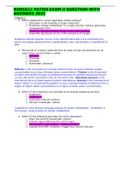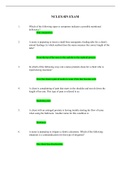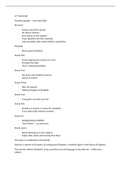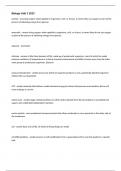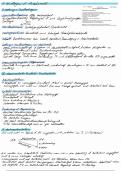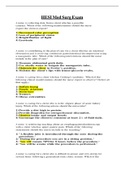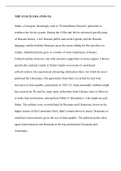Finance 2
Chapter 14
Capital structure is the relative proportions of debt, equity, and other securities
that a firm has outstanding → visualized on Market Value Balance Sheet.
- Left: uses; real/market/fair value of properties if it was on sale now.
- Right: sources; debt + equity
o D/(D + E) = Leverage ratio
o D/E = Debt-to-Equity ratio
o D + E = All Sources = Firm Assets
Debt: investor (debt-holder or creditor) provides refundable money. Legal obligation for debtor to
repay creditor. Debt is also called a bond, and when it is traded it is often called a fixed-income security.
- If you have debt in a sufficiently profitable firm, it is not risky.
- Bankruptcy can happen. Then, not even creditors can be repaid in full:
o Creditors may get a “haircut”
Equity: investor (shareholder) provides non-refundable money. Residual claim on future cash flows.
Equity might be traded as shares on share-market. When traded on an open market, it is called public
or publicly traded.
- Risky: return from stocks is volatile (cannot be diversified away).
- In the event of bankruptcy, equity may be worth zero.
When calculating the NPV of a project, you take into account the risk premium + risk-free interest rate.
- When your NPV is zero, you are being compensated enough to break-even.
Unlevered equity: equity of a firm with no debt. Because there is no debt, the cash flows of the
unlevered equity are equal to those of the project.
If you need 800 euro for a project and get 1000, the 200 more is a compensation for the unique idea.
If there was a stock market where the unlevered equity of the firm is traded, what would this $1000
represent? Stock price or market cap?
- With only one stock (if there are more), it is the stock price.
- With all stocks of the company, it is the market capitalization.
If the price is $1100, you wouldn’t buy the stock (but sell), since this is too high.
If the price is $990, you would buy the stock, since it is worth more.
There are two approaches to figuring out what the value of levered equity is:
- The law of one price
- The homemade leverage idea
The law of one price implies that leverage will not affect the total value of the firm.
- Instead, it merely changes the allocation of cash flows between debt and equity, without
altering the total cash flows of the firm.
Modigliani and Miller (MM) showed that this result holds more generally under a set of conditions
referred to as perfect capital markets:
- Investors and firms can trade the same set of securities at competitive market prices equal to
the present value of their future cash flows.
- There are no taxes, transaction costs, or issuance costs associated with security trading.
, - A firm’s financing decisions do not change the cash flows generated by its investments, nor do
they reveal new information about them.
o By assuming that the uses did not change with change in capital structure, we are
holding the investment unchanged.
- Levered equity is more sensitive to uncertainty (returns are more volatile)
- Bigger swings in returns that are linked to the economy are bigger concerns for equity owners
Expected return (= statistics)
- Take as given current price and future cash flows in each state (strong + weak economy)
- Calculate returns in each possible future state
- Is higher for levered equity than for unlevered equity
Required return (= economics)
- We have a definition of risk
- Individuals are risk-averse: they only tolerate risk if they are compensated sufficiently for it.
- A model of risk and one of investor preferences give you a required return
➔ When calculating the expected return, this is equal to the required return!
So, now that economic thinking has led us to conclude that expected and required return are the same,
we can take a look at expected returns (as an exact synonymous of required return) and riskiness.
- The table below (right) shows that levered equity has double the sensitivity to market risk and
requires double the risk premium!
o Return sensitivity (systematic risk): ∆𝑅 = 𝑅(𝑠𝑡𝑟𝑜𝑛𝑔) − 𝑅(𝑤𝑒𝑎𝑘)
o 𝑅𝑖𝑠𝑘 𝑝𝑟𝑒𝑚𝑖𝑢𝑚 = 𝐸[𝑅] − 𝑟𝑓
,Levered equity is more sensitive to uncertainty: returns are more volatile. Bigger swings in returns that
are linked to the economy are bigger concerns for equity owners. So, leverage increases the risk of the
equity of a firm. Therefore, it is inappropriate to discount the cash flows of levered equity at the same
discount rate of 15% that you used for unlevered equity. Investors in levered equity will require a
higher expected return to compensate for the increased risk.
- Unlevered equity has a return of either 40% or -10% for an expected return of 15%
- Levered equity has higher risk with a return of either 75% or -25%. To compensate for this risk,
levered equity holders receive a higher expected return of 25%
Because the debt’s return bears no systematic risk, its risk premium is zero.
- In this particular case, the levered equity has twice the systematic risk of the unlevered equity
and, as a result, has twice the risk premium.
➔ Leverage increases the risk of equity even when there is no risk that the firm will default.
o Thus, while debt may be cheaper, its use raises the cost of capital for equity.
Considering both sources of capital together, the firm’s average cost of capital with
leverage is the same as for the unlevered firm.
In summary,
- In the case of perfect capital markets, if the firm is 100% equity financed, the equity holders
will require a 15% expected return.
- If the firm is financed 50% with debt and 50% with equity, the debt holders will receive a return
of 5%, while the levered equity holders will require an expected return of 25% (because of
their increased risk).
- The change in the risk of equity does not change the value of the firm (by the assumption that
the investment opportunities are unaffected by capital structure)
Exam: at what rate of leverage does the debt not equal 5%?
E = market value of equity in a levered firm
D = market value of debt in a levered firm
U = market value of equity in an unlevered firm
A = market value of the firm’s assets
MM Proposition I: E + D = U = A
- The total market value of the firm’s securities is equal to the market value of its assets,
whether the firm is unlevered or levered.
The return on unlevered equity (𝑅𝑈 ) is related to the returns of levered equity (𝑅𝐸 ) and debt (𝑅𝐷 ).
Solving for 𝑅𝐸 :
- The levered equity return equals the unlevered return + a premium due to leverage
o The amount of the premium depends on the amount of leverage, measured by the
firm’s market value debt-equity ratio (D/E)
MM Proposition II: the cost of capital of levered equity is equal to the cost of capital of unlevered
equity + a premium that is proportional to the market value debt-equity ratio.
- Cost of Capital of Levered Equity 𝑟𝐸
, o Recall from above: if the firm is all-equity financed, the expected return on unlevered
equity (𝑅𝑈 ) is 15%. If the firm is financed with $500 of debt, the expected return of
debt (𝑅𝐷 ) is 5%. Therefore, the expected return on equity (𝑅𝐸 ) for the levered firm is:
If a firm is unlevered, all of the free cash flows generated by its assets are paid out to its equity holders.
The market value, risk, and cost of capital for the firm’s assets and its equity coincide and therefore:
𝑟𝑈 = 𝑟𝐴
If a firm is levered, project 𝑟𝐴 is equal to the firm’s weighted average cost of capital:
- Unlevered Cost of Capital (pretax WACC):
a) With perfect capital markets, a firm’s WACC is independent of its
capital structure and is equal to its equity cost of capital if it is
unlevered, which matches the cost of capital of its assets.
b) Debt-to-Value ratio: the fraction of a firm’s enterprise value that
corresponds to debt.
- Without any debt, the WACC is equal to the unlevered equity cost
of capital. As the firm borrows at the low cost of capital for debt,
its equity cost of capital rises. The net effect is that the firm’s
WACC is unchanged.
Leveraged recapitalization: when a firm uses borrowed funds to pay a large special dividend or
repurchase a significant amount of outstanding shares (see problem 14.15).
The effect of leverage on the risk of a firm’s securities can also be expressed in terms of beta:
- Unlevered beta: a measure of the risk of a firm as if it did not have leverage, which is equivalent
to the beta of the firm’s assets.
o If you are trying to estimate the unlevered beta for an investment project, you should
base your estimate on the unlevered betas of firms with comparable investments.
- Leverage amplifies the market risk of a firm’s assets (𝛽𝑈 ), raising the market risk of its equity.
It is sometimes incorrectly believed that because leverage can increase earnings per share (EPS),
leverage can increase the stock price as well.
Dilution: issuing equity will dilute existing shareholders’ ownership, so debt financing should be used
instead. It is incorrectly argued that if the firm issues new shares, the cash flows generated by the firm
must be divided among a larger number of shares, thereby reducing the value of each individual share.
- The problem with this line of reasoning is that it ignores the fact that the cash raised by issuing
new shares will increase the firm’s assets.
Chapter 14
Capital structure is the relative proportions of debt, equity, and other securities
that a firm has outstanding → visualized on Market Value Balance Sheet.
- Left: uses; real/market/fair value of properties if it was on sale now.
- Right: sources; debt + equity
o D/(D + E) = Leverage ratio
o D/E = Debt-to-Equity ratio
o D + E = All Sources = Firm Assets
Debt: investor (debt-holder or creditor) provides refundable money. Legal obligation for debtor to
repay creditor. Debt is also called a bond, and when it is traded it is often called a fixed-income security.
- If you have debt in a sufficiently profitable firm, it is not risky.
- Bankruptcy can happen. Then, not even creditors can be repaid in full:
o Creditors may get a “haircut”
Equity: investor (shareholder) provides non-refundable money. Residual claim on future cash flows.
Equity might be traded as shares on share-market. When traded on an open market, it is called public
or publicly traded.
- Risky: return from stocks is volatile (cannot be diversified away).
- In the event of bankruptcy, equity may be worth zero.
When calculating the NPV of a project, you take into account the risk premium + risk-free interest rate.
- When your NPV is zero, you are being compensated enough to break-even.
Unlevered equity: equity of a firm with no debt. Because there is no debt, the cash flows of the
unlevered equity are equal to those of the project.
If you need 800 euro for a project and get 1000, the 200 more is a compensation for the unique idea.
If there was a stock market where the unlevered equity of the firm is traded, what would this $1000
represent? Stock price or market cap?
- With only one stock (if there are more), it is the stock price.
- With all stocks of the company, it is the market capitalization.
If the price is $1100, you wouldn’t buy the stock (but sell), since this is too high.
If the price is $990, you would buy the stock, since it is worth more.
There are two approaches to figuring out what the value of levered equity is:
- The law of one price
- The homemade leverage idea
The law of one price implies that leverage will not affect the total value of the firm.
- Instead, it merely changes the allocation of cash flows between debt and equity, without
altering the total cash flows of the firm.
Modigliani and Miller (MM) showed that this result holds more generally under a set of conditions
referred to as perfect capital markets:
- Investors and firms can trade the same set of securities at competitive market prices equal to
the present value of their future cash flows.
- There are no taxes, transaction costs, or issuance costs associated with security trading.
, - A firm’s financing decisions do not change the cash flows generated by its investments, nor do
they reveal new information about them.
o By assuming that the uses did not change with change in capital structure, we are
holding the investment unchanged.
- Levered equity is more sensitive to uncertainty (returns are more volatile)
- Bigger swings in returns that are linked to the economy are bigger concerns for equity owners
Expected return (= statistics)
- Take as given current price and future cash flows in each state (strong + weak economy)
- Calculate returns in each possible future state
- Is higher for levered equity than for unlevered equity
Required return (= economics)
- We have a definition of risk
- Individuals are risk-averse: they only tolerate risk if they are compensated sufficiently for it.
- A model of risk and one of investor preferences give you a required return
➔ When calculating the expected return, this is equal to the required return!
So, now that economic thinking has led us to conclude that expected and required return are the same,
we can take a look at expected returns (as an exact synonymous of required return) and riskiness.
- The table below (right) shows that levered equity has double the sensitivity to market risk and
requires double the risk premium!
o Return sensitivity (systematic risk): ∆𝑅 = 𝑅(𝑠𝑡𝑟𝑜𝑛𝑔) − 𝑅(𝑤𝑒𝑎𝑘)
o 𝑅𝑖𝑠𝑘 𝑝𝑟𝑒𝑚𝑖𝑢𝑚 = 𝐸[𝑅] − 𝑟𝑓
,Levered equity is more sensitive to uncertainty: returns are more volatile. Bigger swings in returns that
are linked to the economy are bigger concerns for equity owners. So, leverage increases the risk of the
equity of a firm. Therefore, it is inappropriate to discount the cash flows of levered equity at the same
discount rate of 15% that you used for unlevered equity. Investors in levered equity will require a
higher expected return to compensate for the increased risk.
- Unlevered equity has a return of either 40% or -10% for an expected return of 15%
- Levered equity has higher risk with a return of either 75% or -25%. To compensate for this risk,
levered equity holders receive a higher expected return of 25%
Because the debt’s return bears no systematic risk, its risk premium is zero.
- In this particular case, the levered equity has twice the systematic risk of the unlevered equity
and, as a result, has twice the risk premium.
➔ Leverage increases the risk of equity even when there is no risk that the firm will default.
o Thus, while debt may be cheaper, its use raises the cost of capital for equity.
Considering both sources of capital together, the firm’s average cost of capital with
leverage is the same as for the unlevered firm.
In summary,
- In the case of perfect capital markets, if the firm is 100% equity financed, the equity holders
will require a 15% expected return.
- If the firm is financed 50% with debt and 50% with equity, the debt holders will receive a return
of 5%, while the levered equity holders will require an expected return of 25% (because of
their increased risk).
- The change in the risk of equity does not change the value of the firm (by the assumption that
the investment opportunities are unaffected by capital structure)
Exam: at what rate of leverage does the debt not equal 5%?
E = market value of equity in a levered firm
D = market value of debt in a levered firm
U = market value of equity in an unlevered firm
A = market value of the firm’s assets
MM Proposition I: E + D = U = A
- The total market value of the firm’s securities is equal to the market value of its assets,
whether the firm is unlevered or levered.
The return on unlevered equity (𝑅𝑈 ) is related to the returns of levered equity (𝑅𝐸 ) and debt (𝑅𝐷 ).
Solving for 𝑅𝐸 :
- The levered equity return equals the unlevered return + a premium due to leverage
o The amount of the premium depends on the amount of leverage, measured by the
firm’s market value debt-equity ratio (D/E)
MM Proposition II: the cost of capital of levered equity is equal to the cost of capital of unlevered
equity + a premium that is proportional to the market value debt-equity ratio.
- Cost of Capital of Levered Equity 𝑟𝐸
, o Recall from above: if the firm is all-equity financed, the expected return on unlevered
equity (𝑅𝑈 ) is 15%. If the firm is financed with $500 of debt, the expected return of
debt (𝑅𝐷 ) is 5%. Therefore, the expected return on equity (𝑅𝐸 ) for the levered firm is:
If a firm is unlevered, all of the free cash flows generated by its assets are paid out to its equity holders.
The market value, risk, and cost of capital for the firm’s assets and its equity coincide and therefore:
𝑟𝑈 = 𝑟𝐴
If a firm is levered, project 𝑟𝐴 is equal to the firm’s weighted average cost of capital:
- Unlevered Cost of Capital (pretax WACC):
a) With perfect capital markets, a firm’s WACC is independent of its
capital structure and is equal to its equity cost of capital if it is
unlevered, which matches the cost of capital of its assets.
b) Debt-to-Value ratio: the fraction of a firm’s enterprise value that
corresponds to debt.
- Without any debt, the WACC is equal to the unlevered equity cost
of capital. As the firm borrows at the low cost of capital for debt,
its equity cost of capital rises. The net effect is that the firm’s
WACC is unchanged.
Leveraged recapitalization: when a firm uses borrowed funds to pay a large special dividend or
repurchase a significant amount of outstanding shares (see problem 14.15).
The effect of leverage on the risk of a firm’s securities can also be expressed in terms of beta:
- Unlevered beta: a measure of the risk of a firm as if it did not have leverage, which is equivalent
to the beta of the firm’s assets.
o If you are trying to estimate the unlevered beta for an investment project, you should
base your estimate on the unlevered betas of firms with comparable investments.
- Leverage amplifies the market risk of a firm’s assets (𝛽𝑈 ), raising the market risk of its equity.
It is sometimes incorrectly believed that because leverage can increase earnings per share (EPS),
leverage can increase the stock price as well.
Dilution: issuing equity will dilute existing shareholders’ ownership, so debt financing should be used
instead. It is incorrectly argued that if the firm issues new shares, the cash flows generated by the firm
must be divided among a larger number of shares, thereby reducing the value of each individual share.
- The problem with this line of reasoning is that it ignores the fact that the cash raised by issuing
new shares will increase the firm’s assets.


